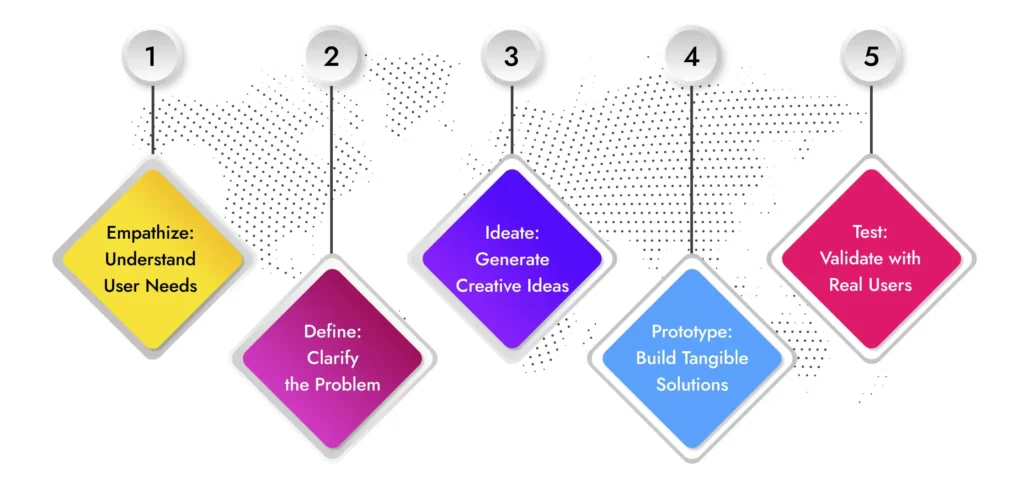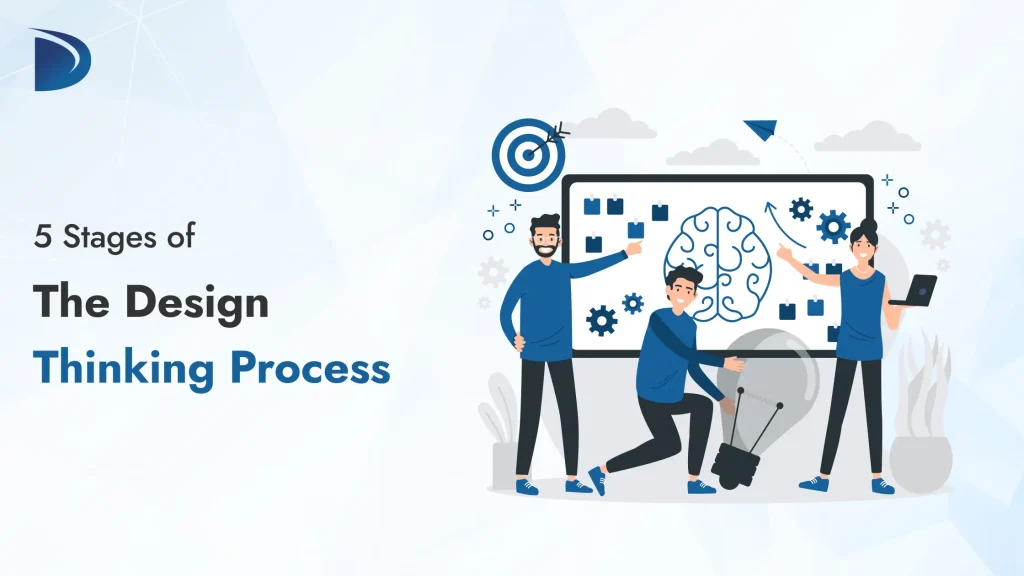Table of Contents
Stages of the Design Thinking Process is a strong problem-solving method that values people. It has helped some of the world’s largest corporations, including Google, Apple, and IBM, in developing new products and improving consumer experiences. But what is the best part? It’s not limited to technology organizations. Any business may utilize design thinking to increase creative thinking, solve challenges, and develop solutions that genuinely make a difference.
Understanding the Five Stages of the Design Thinking Process is essential for anyone wishing to solve problems in a creative, user-centred way. It provides an extensive understanding of users’ wants and issues, enabling the development of new and practical solutions. This approach is widely used by designers, product developers, and teams across various industries to improve user experiences and drive successful outcomes.
The stages of the design thinking process are fundamentally about knowing and caring for people, including their needs, feelings, and experiences. This technique is flexible, so you can go back to any stage if new ideas or issues come up. The five phases of design thinking are Empathize, Define, Ideate, Prototype, and Test.
It helps teams:
- Empathize: Understand existing products and identify ways to improve them by addressing user needs.
- Define: Develop fresh ideas to serve customers in innovative ways and clearly define the problem.
- Ideate: Explore what people truly need and want in order to generate creative solutions.
- Prototype: Think creatively about potential solutions and build tangible prototypes.
- Test: Test these prototypes with real users to validate what works and refine the solution.

Let’s explore each step in detail:
1. Empathize: Understand User Needs
The first step in the Design Thinking process is to deeply understand the users by learning about their experiences, emotions, challenges, and goals. This helps make sure that the solution you create is focused on real human needs and solves actual problems.
Ways to Include Empathizing in Your Process:
- Conduct User Interviews and Surveys: Collect qualitative data to understand users’ behaviours, goals, and challenges.
- Observe Users in Their Natural Environments: Watch how users interact with current solutions to gain deeper insights.
- Use Personas: Create personas to represent different types of users, helping you design solutions that address a variety of needs and experiences.
By thoroughly understanding the user’s perspective, you build a solid foundation for solving the right problem.
2. Define: Clarify the Problem
In the Define phase, you take the insights gathered during the Empathize phase and distil them into a clear, actionable problem statement. This helps ensure that your team is aligned and working toward a common goal.
How to Define the Problem in Design Thinking:
- Synthesize Research Findings: Turn research into a clear problem statement that focuses on users’ needs, helping design thinking to define the problem effectively.
- Use Tools to Organize Data: Use tools like user journey maps or affinity diagrams to organize and analyze user data.
- Frame the Problem: Approach the problem with a focus on both user needs and business goals.
- Keep the Team Focused: A well-defined problem statement keeps the team on track and guides the ideation process to find the right solutions.
A well-defined problem will keep your team focused and guide the ideation process, helping you avoid solutions that may miss the mark.
3. Ideate: Generate Creative Ideas
In the Stages of the Design Thinking Process, the ideate phase is where creativity really shines. The goal is to come up with as many ideas and possible solutions as you can without any judgment. It’s a time to explore many options and question old assumptions.
How to ideate effectively in the Design Thinking process:
- Hold Brainstorming Sessions: Get everyone involved and encourage all ideas, even the wild ones.
- Use Creative Tools: Try tools like mind maps or brainwriting to explore the problem from different perspectives.
- Encourage Divergent Thinking: Suspend judgment and consider every idea, even if it seems unconventional.
The key is to generate a large pool of ideas and identify the ones with the most potential to solve the problem effectively.
4. Prototype: Build Tangible Solutions
In the Prototyping phase, you start turning your ideas into something real. Prototypes can range from simple paper sketches or wireframes to fully working models, depending on the project’s needs. This phase is all about testing your concepts and getting feedback before settling on a final design.
Tips for prototyping:
- Start with Low-Fidelity Prototypes: Use simple tools like paper mockups or wireframes to test ideas quickly without using too many resources.
- Focus on Key Features: Concentrate on the main features that solve the problem rather than aiming for a perfect, polished design.
- Use Rapid Prototyping: Make quick adjustments based on feedback to improve the design as you go.
Prototypes serve as a testing ground for your ideas, allowing you to learn, iterate, and refine your solutions.
5. Test: Validate with Real Users
In the Testing phase, you present your prototype to real users to gather feedback and spot any usability issues or areas that need improvement. This phase helps confirm whether your solution actually meets user needs and solves the problem effectively.
Best practices for testing:
- Conduct Usability Tests: Observe how users interact with your prototype to identify any issues.
- Collect Data: Gather both qualitative (e.g., interviews, surveys) and quantitative (e.g., analytics) data to measure user satisfaction and usability.
- Iterate and Retest: Make improvements to your prototype based on feedback and test again to ensure the solution is fully optimized.
Testing is a crucial phase because it gives you the opportunity to refine your solution before launch.
How to Integrate Design Thinking into Your Organization
While design thinking is a powerful tool for innovation, implementing the process in your organization requires thoughtful planning and commitment. Here are some practical tips to help bring Design Thinking to life in your workplace:
1. Understand the Ideology
Design Thinking is both a methodology and a mindset. It’s about adopting a human-centred, iterative approach to problem-solving. Although there are variations in how companies implement Design Thinking, the core principles remain the same: empathy for the user, a clear problem definition, creativity in ideation, and iterative prototyping and testing.
By understanding the underlying ideology of Design Thinking, you can build a culture of innovation within your team or organization.
2. Take It Seriously
To successfully implement Design Thinking, your organization must take it seriously. This doesn’t mean hiring expensive experts but rather committing to a structured process. It’s about creating a dedicated space and resources for the method to thrive and ensuring that teams follow the principles with integrity.
Implementing Design Thinking isn’t about cutting corners It’s about investing in the process and committing to thorough research, ideation, and testing.
3. Start Small
If your organization is new to Design Thinking, it’s important to start small and experiment. Begin with a few pilot projects to practice gathering data, testing ideas, and iterating quickly. This allows you to learn from early successes and failures without overwhelming your team.
Consider launching small-scale projects where the stakes are lower, and the team can focus on refining the methodology and getting comfortable with the process.
4. Measure Success
Introducing Design Thinking to your team is a significant effort, so it’s important to track progress and measure its impact. Set Key Performance Indicators (KPIs) to gauge how well the method is being implemented. For example:
- Track the number of projects that apply Design Thinking.
- Measure the quality and frequency of user interviews conducted.
- Assess employee satisfaction and engagement with the Design Thinking process.
By measuring success, you ensure that the methodology is creating value for your team and organization.
5. Reverse Your Thinking
Design Thinking encourages you to approach problems from a fresh perspective. One useful technique is to “reverse” the problem,, by imagining the worst-case scenario or thinking about what things would be like if the problem didn’t exist. This can help you prioritize key issues and come up with new ideas you might not have thought of before.
By questioning assumptions and viewing things from a different angle, you can unlock more creative and effective solutions.
Conclusion
Stages of the Design Thinking Process is a powerful method for sparking innovation and solving complex problems by following the steps Empathize, Define, Ideate, Prototype, and Test. You can create solutions that are focused on users’ real needs. Whether you’re designing products, services, or business strategies, Design Thinking provides a structured yet flexible framework to explore new ideas and find better solutions.
Although it may take time to fully adopt the five stages of the design thinking process in your organization, starting small, staying committed, and measuring success will help you achieve long-term results. Remember, design thinking is an iterative process, so be ready to revisit earlier steps as you learn more and improve your solutions. By embracing this approach, your team can solve problems creatively and effectively.

